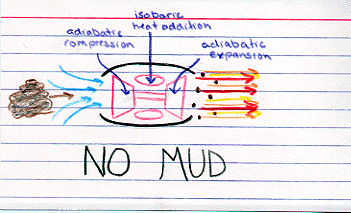

General comments
After the difficult parts of the steady flow energy equation, I think the relatively easier concepts that surround reversible and irreversible processes are welcome. Note there are two points that are frequently are misunderstood. The first is the detail of the temperature being constant for an adiabatic free expansion (it really is). The second is that sometimes people forget that the test of reversibility is that both the system and the surroundings are returned to their initial state (it is not enough to put Humpty Dumpty back together again, the whole world has to go back together again too). If this is confusing, think of the example of the chalk. I dropped it and it broke (the forward process). I can pick it up again and put it back together (the reverse process). When I am done the chalk is back to its original state, but I am not. I have used fuel (blood sugar) to do work producing waste heat. Also remember that one of the most important points is that the degree of irreversibility is related to the amount of lost work. Think of the Mars bubble popping and brick contacting example to remind you of this.
The Mars thing was freaking hilarious. Who knew thermo could be remotely funny at all? and other expressions of amusement (6 students)
P.S. The Future does not look bright... I would have popped the gas bubble!!! (1 student) Please accept my condolences.
By the way - it takes only 6 to 7 months to travel to Mars, and the radiation dose that would be received on the way there is not very significant! To find out more come to Mars week @MIT! Oct. 20-22. (1 student) Okay. I have posted your message here as free advertising.
So if I throw my prs clicker into a black hole would $50 disappear from my wallet? (1 student) Yes. This is called the Second Law of Unified.
On a side note, I once pulled something out of a black hole, therefore that one guy must be wrong (1 student). I thought so. Me too.
Someday I'm going to be walking on Mars and say "Hey, remember when Waitz was talking about popping pressure pockets in Thermo?" And someone will know what I'm talking about and crack up. (And then, maybe, I'll pop one, just for old times' sake). (1 student) I hope you get there (and then show a little restraint please).
How much will we be tested on the Second Law? (1 student) You will not be tested on the Second Law. You will be tested on reversible and irreversible processes and you are expected to know that entropy is a property (and therefore a function of the state of the system) that allows you to measure the degree of irreversibility of a process.
Having lecture and recitation for the same subject in the same day makes it very tedious, especially when you use the exact same example (1 student). Yes. It is tedious for me too. I would very much prefer not to teach three classes in a row on the same material to the same group. We try to arrange it so that this does not happen, but occasionally it does. Sorry about using the chalk example twice--I thought it was particularly instructive.


Responses to 'Muddiest Part of the Lecture Cards'
(57 respondents)
1) If the other side of the boundary (in the first example) wasn't vacuum, then what would the temperature do? (two gases would mix together?) (1 student) If the two gases started at the same temperature (and did not react), then they would just mix and the temperature would stay constant. This problem is solved in one of the later chapters of SB&VW (if I had my book with me I would tell you where). Essentially, you would treat each gas as undergoing a free expansion into the other (unless they were the same gas). You can think of it in terms of partial pressures. Gas A on one side has a partial pressure equal to the full pressure (and similar for gas B on the other side), then when the membrane is removed, Gas A and Gas B both expand (non-quasi-statically) to fill the entire container but with their partial pressure cut in half. So it is two simultaneous free expansions. But don't worry about this. You won't have to do thermodynamics with multi-component mixtures until 16.050.
2) For free expansion, do you mean if for any real situation pext not equal to zero in any case, although pext approaches zero. T will drop? (1 student) I had trouble understanding your question, but let me try an answer anyway. If the pressure on the other side of the membrane is not zero but some finite pressure that is less than the pressure on the other side, there will still be no change in temperature for the system. You can draw a boundary around the whole rigid, thermally-insulated box (as we did in class) to show this.
3) Does Du=0 always mean that the temp is constant? (1 student) Only for an ideal gas (where du=cvdT, u is a function of T only). In general u would be a function of two independent thermodynamic properties. Therefore it would be possible (for a non ideal gas) to have the pressure and temperature both change, but do so in a balanced way so that the internal energy was constant.
4) In the free expansion example: What if the container was not thermally insulated? Now q is not necessarily zero. Is the process reversible? Does any heat actually flow since w=0? I don't get it. (1 student) The process is not reversible in this case. There is still a free expansion. Depending on how much heat flows, that will set the temperature (by the First Law). So for example if you have a free expansion and allow 5 Joules of heat to flow into the chamber, then the temperature would go up (DT=5/cv/mass in degrees Kelvin if it was an ideal gas).
5) In PRS 1, is there any work involved with popping/removing the membrane? Is this work related to the work required to reverse the process anyway? (1 student) Yes there would be work associated with this and it would have to be accounted for as part of the process. However, the membrane I envisioned for the problem is one of these hypothetically-thin, massless membranes (just so that it doesn't obscure the main point of the comparison).
6) Mud: Getting a good grip on what are the surroundings (it could be a lot of things). (1 student) Yes it could. Don't worry about this too much for now. What I want you to understand is that in judging the degree of irreversibility you need to consider both the system and the surroundings. The details of how to do this are really a topic for 16.050.
7) What physically is entropy? (1 student) I was afraid someone would ask this. There are as many answers as there are people that teach thermodynamics. My answer is not a physical one. It is a useful property (that can be determined from knowing the state of the system), that measures the irreversibility or lost ability to do work associated with a process.
8) Why is Dssurround = 0 for an adiabatic process? Is it empirically determined? (1 student) This is a topic for 16.050, but here is a short answer. There are only two ways to change the entropy of a system 1) if irreversibilities (friction, free expansion, mixing, heat transfer across a finite temperature difference, etc.) are present inside the system, and 2) if there is heat transfer to or from the system. So only one of the two possible energy exchange processes (heat not work) can change the entropy when energy is passed between a system and the surroundings. Therefore if the process the system undergoes is adiabatic, then there is no way to change the entropy of the surroundings (work won't do it and there is no heat transfer).
9) Can you explain how did you get the entropy formula? (1 student) Read over the section in the notes that discusses this.
10) The state of a system is defined at equilibrium, so how can a property of a system be defined solely as an equation with differentials? (1 student) Technically, it can't. You need to integrate the equation and determine the constant (the entropy of a reference state). The equations that follow the one you are referring to in the notes do this.
11)Can we calculate the entropy for an individual object, or can we only calculate changes in entropy? Ex. What is my entropy at this moment? (1 student) Yes you can calculate the entropy of an object. You do it the same way you would calculate the enthalpy or the internal energy. You would go to one of the tables in the back of SB&VW that lists reference values of entropy. These are obtained from experiments and would be given at a particular state (typically, 1 atm and 296K). Then you would use the equation for Ds to determine how much to add to the reference value to get to the state you are interested in.
12) You mentioned nozzles trading pressure/energy for velocity. I've heard of home water heaters that use some sort of nozzle technology to have a water flow input and immediately heat the water at the output without a reservoir. Are you familiar with anything like this? How would that work? (1 student) No I am not familiar with anything like that, but if you have some product literature I would be happy to sit down and try to puzzle it out. I would guess that they are just using localized heating of the fluid stream with a small electrically driven heat exchanger.
13) No mud (45 students). Great.